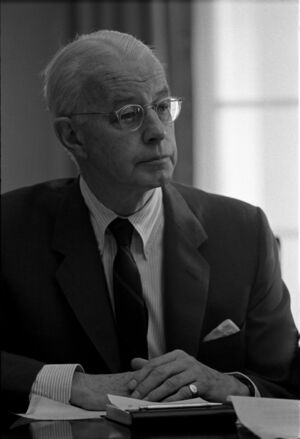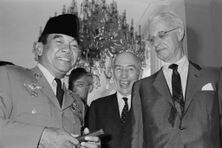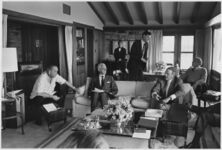Difference between revisions of "Ellsworth Bunker"
(Diplomat with many deep state friends) |
m (Text replacement - "Early life and education" to "Background") |
||
| (2 intermediate revisions by 2 users not shown) | |||
| Line 13: | Line 13: | ||
|description=Cold War hawk, diplomatic troubleshooter | |description=Cold War hawk, diplomatic troubleshooter | ||
||employment={{job | ||employment={{job | ||
| − | |title= | + | |title=US/Ambassador/South Vietnam |
|start=April 5, 1967 | |start=April 5, 1967 | ||
|end=May 11, 1973 | |end=May 11, 1973 | ||
| Line 21: | Line 21: | ||
|end= November 7, 1966 | |end= November 7, 1966 | ||
}}{{job | }}{{job | ||
| − | |title= | + | |title=US/Ambassador/India |
|start=November 28, 1956 | |start=November 28, 1956 | ||
|end=March 23, 1961 | |end=March 23, 1961 | ||
| + | |description=Also accredited to Nepal | ||
| + | }}{{job | ||
| + | |title=US/Ambassador/Nepal | ||
| + | |start=March 8, 1957 | ||
| + | |end=November 25, 1959 | ||
| + | |description=Also for India. Resident at [[New Delhi]]. | ||
}}{{job | }}{{job | ||
|title=American Red Cross/President | |title=American Red Cross/President | ||
| Line 29: | Line 35: | ||
|end= November 1956 | |end= November 1956 | ||
}}{{job | }}{{job | ||
| − | |title= | + | |title=US/Ambassador/Italy |
|start=May 7, 1952 | |start=May 7, 1952 | ||
|end=April 3, 1953 | |end=April 3, 1953 | ||
}}{{job | }}{{job | ||
| − | |title= | + | |title=US/Ambassador/Argentina |
|start=March 13, 1951 | |start=March 13, 1951 | ||
|end=March 12, 1952 | |end=March 12, 1952 | ||
| Line 40: | Line 46: | ||
'''Ellsworth F. Bunker''' <ref>https://query.nytimes.com/gst/fullpage.html?res=9504EEDD123BF931A35753C1A962948260 </ref> was an American businessman and diplomat (including being the ambassador to Argentina, Italy, India, Nepal and South Vietnam). He is perhaps best known for being a [[War Hawk|hawk]] on the war in [[Vietnam War|Vietnam and Southeast Asia]] during the 1960s and 1970s. {{As of|February 2021}}, Bunker is one of two people to receive the [[Presidential Medal of Freedom]] twice. | '''Ellsworth F. Bunker''' <ref>https://query.nytimes.com/gst/fullpage.html?res=9504EEDD123BF931A35753C1A962948260 </ref> was an American businessman and diplomat (including being the ambassador to Argentina, Italy, India, Nepal and South Vietnam). He is perhaps best known for being a [[War Hawk|hawk]] on the war in [[Vietnam War|Vietnam and Southeast Asia]] during the 1960s and 1970s. {{As of|February 2021}}, Bunker is one of two people to receive the [[Presidential Medal of Freedom]] twice. | ||
| − | == | + | ==Background== |
Born in [[Yonkers, New York]], he was the eldest of three children of George Raymond Bunker and Jeanie Polhemus (''née'' Cobb), whose family descended from prominent early Dutch settlers including the Evertson family and the [[Schuyler family]]. His great-grandmother Eliza Brodhead Polhemus ''née'' Heyer was a niece of [[Stephen Whitney]], reputedly the wealthiest American of his time after [[John Jacob Astor]], while her first cousin Charles Suydam was the brother-in-law of Astor's grandson [[William Backhouse Astor Jr.]] and his wife [[Caroline Schermerhorn Astor]].<ref name=NolanCJ-p48>https://archive.org/details/notableusambassa00west/page/48</ref><ref name=RobertH-GreensfelderNS>{Roberts, Harry Jr.; and Nelson Sutro Greensfelder (1949). The Explosives Engineer: Volumes 27-29. Hercules Powder Co. p. 4.</ref><ref>Institute for Research in Biography (1957). Who's Who in Commerce and Industry, Volume 10. New York, N.Y.: Marquis Who's Who. p. 167.</ref> Bunker's father was one of the founders and chairman of the board of National Sugar Refining Company. His younger brother, Arthur Hugh Bunker (July 29, 1895 – May 19, 1964), was also a noted businessman, chairman of the executive committee of the [[War Production Board]] (1941–1945) during World War II, and president and then board chairman of American Metal Climax (AMAX).<ref name=RobertH-GreensfelderNS/><ref>"Arthur H. Bunker Dead at 68". The New York Times. May 20, 1964.</ref> His cousin, Dorothy Penrose Cobb, was married to historian [[Frederick Lewis Allen]]. | Born in [[Yonkers, New York]], he was the eldest of three children of George Raymond Bunker and Jeanie Polhemus (''née'' Cobb), whose family descended from prominent early Dutch settlers including the Evertson family and the [[Schuyler family]]. His great-grandmother Eliza Brodhead Polhemus ''née'' Heyer was a niece of [[Stephen Whitney]], reputedly the wealthiest American of his time after [[John Jacob Astor]], while her first cousin Charles Suydam was the brother-in-law of Astor's grandson [[William Backhouse Astor Jr.]] and his wife [[Caroline Schermerhorn Astor]].<ref name=NolanCJ-p48>https://archive.org/details/notableusambassa00west/page/48</ref><ref name=RobertH-GreensfelderNS>{Roberts, Harry Jr.; and Nelson Sutro Greensfelder (1949). The Explosives Engineer: Volumes 27-29. Hercules Powder Co. p. 4.</ref><ref>Institute for Research in Biography (1957). Who's Who in Commerce and Industry, Volume 10. New York, N.Y.: Marquis Who's Who. p. 167.</ref> Bunker's father was one of the founders and chairman of the board of National Sugar Refining Company. His younger brother, Arthur Hugh Bunker (July 29, 1895 – May 19, 1964), was also a noted businessman, chairman of the executive committee of the [[War Production Board]] (1941–1945) during World War II, and president and then board chairman of American Metal Climax (AMAX).<ref name=RobertH-GreensfelderNS/><ref>"Arthur H. Bunker Dead at 68". The New York Times. May 20, 1964.</ref> His cousin, Dorothy Penrose Cobb, was married to historian [[Frederick Lewis Allen]]. | ||
| − | Ellsworth Bunker studied to be a [[lawyer]], and graduated from [[Yale University]] with the class of 1916.<ref name=NolanCJ-p48/> During World War II he | + | Ellsworth Bunker studied to be a [[lawyer]], and graduated from [[Yale University]] with the class of 1916.<ref name=NolanCJ-p48/> During World War II he was chairman of the War Production Board's cane sugar advisory committee.<ref>"WPB Official Testifies Sugar Imports Are Cut 50 Per Cent". Chicago Tribune. March 24, 1942.</ref> |
==Career== | ==Career== | ||
[[File:Ellsworth Bunker with Indonesian President Soekarno.jpg|left|thumb|222x222px|Ellsworth Bunker with [[President of Indonesia|Indonesian President]] [[Soekarno]] at [[Merdeka Palace]] during a visit to [[Jakarta]], [[Indonesia]] March 1965.]] | [[File:Ellsworth Bunker with Indonesian President Soekarno.jpg|left|thumb|222x222px|Ellsworth Bunker with [[President of Indonesia|Indonesian President]] [[Soekarno]] at [[Merdeka Palace]] during a visit to [[Jakarta]], [[Indonesia]] March 1965.]] | ||
Latest revision as of 14:08, 13 September 2024
(diplomat, deep state functionary) | ||||||||||
|---|---|---|---|---|---|---|---|---|---|---|
 | ||||||||||
| Born | May 11, 1894 | |||||||||
| Died | September 27, 1984 (Age 90) | |||||||||
| Nationality | US | |||||||||
| Alma mater | Yale University | |||||||||
| Member of | Bohemian Grove, Council on Foreign Relations/Historical Members | |||||||||
Cold War hawk, diplomatic troubleshooter
| ||||||||||
Ellsworth F. Bunker [1] was an American businessman and diplomat (including being the ambassador to Argentina, Italy, India, Nepal and South Vietnam). He is perhaps best known for being a hawk on the war in Vietnam and Southeast Asia during the 1960s and 1970s. As of February 2021[update], Bunker is one of two people to receive the Presidential Medal of Freedom twice.
Contents
Background
Born in Yonkers, New York, he was the eldest of three children of George Raymond Bunker and Jeanie Polhemus (née Cobb), whose family descended from prominent early Dutch settlers including the Evertson family and the Schuyler family. His great-grandmother Eliza Brodhead Polhemus née Heyer was a niece of Stephen Whitney, reputedly the wealthiest American of his time after John Jacob Astor, while her first cousin Charles Suydam was the brother-in-law of Astor's grandson William Backhouse Astor Jr. and his wife Caroline Schermerhorn Astor.[2][3][4] Bunker's father was one of the founders and chairman of the board of National Sugar Refining Company. His younger brother, Arthur Hugh Bunker (July 29, 1895 – May 19, 1964), was also a noted businessman, chairman of the executive committee of the War Production Board (1941–1945) during World War II, and president and then board chairman of American Metal Climax (AMAX).[3][5] His cousin, Dorothy Penrose Cobb, was married to historian Frederick Lewis Allen.
Ellsworth Bunker studied to be a lawyer, and graduated from Yale University with the class of 1916.[2] During World War II he was chairman of the War Production Board's cane sugar advisory committee.[6]
Career


Bunker first worked in his father's company, National Sugar Refining Company,[2] eventually becoming the company's president, succeeding Horace Havemeyer Sr., in 1942. He retired as an active executive in 1951.[7] He remained a member of the board of National Sugar until 1966.[8]
He then moved to government during the Harry S. Truman administration, when Truman appointed him ambassador to Argentina in April 1951.[9] Next he was ambassador to Italy in February 1952.[10] From November 1953 until November 1956 he was president of the American Red Cross.[11][12] In November 1956 he was appointed ambassador to India and Nepal by Dwight D. Eisenhower,[13][14] and sworn in December 1956, where he played a crucial role in the covert alliance between the two powers against China. He was replaced by John Kenneth Galbraith in 1961. During 1962 he acted as U.S. mediator in the New York Agreement over Western New Guinea.
After a period back in Washington, D.C., he was made U.S. ambassador to the Organization of American States, 1964–1966. President Lyndon B. Johnson appointed him U.S. ambassador to South Vietnam, 1967–1973.[15] Once in Saigon, he strongly supported the war efforts of Presidents Johnson and Richard Nixon, and applauded US incursions into Laos and Cambodia.[16] Following the conclusion of the Vietnam War, Bunker headed the US team involved in the drawing up of the 1977 Torrijos-Carter Treaties.
He was awarded the Presidential Medal of Freedom with Distinction twice—the first time by John F. Kennedy in 1963 (though the ceremony took place during Lyndon B Johnson's term) and the second time by Lyndon B. Johnson in 1967. He is one of only two persons (the other being Colin Powell) who received the award twice, and the only person to receive it both times with distinction.
Personal life
Bunker married a neighbor, Harriet Allen Butler, daughter of Ellen Mudge and George Prentiss Butler, in Yonkers, New York on April 24, 1920.[17] Harriet had made friends with Bunkers' sister Katherine when the two girls attended Miss Porter's School in Farmington, Connecticut.[18] They had three children, John Birkbeck, Samuel Emmet, and Ellen Mudge.[19] She died in 1964.[20]
On January 3, 1967 he married fellow ambassador Caroline Clendening "Carol" Laise in Katmandu, Nepal.[21] She died in 1991. Ambassador Laise was a friend of the first Mrs. Bunker.[22]
Bunker died on his dairy farm in Putney, Vermont. The funeral was attended by his good friend and neighbor former senator George Aiken and former president Richard M. Nixon. Aiken died two months later.
His middle child, John Birkbeck Bunker (March 8, 1926 – May 26, 2005), a first lieutenant in World War II, died of cancer at his home in Wheatland, Wyoming at age 79.[23]
References
- ↑ https://query.nytimes.com/gst/fullpage.html?res=9504EEDD123BF931A35753C1A962948260
- ↑ a b c https://archive.org/details/notableusambassa00west/page/48
- ↑ a b {Roberts, Harry Jr.; and Nelson Sutro Greensfelder (1949). The Explosives Engineer: Volumes 27-29. Hercules Powder Co. p. 4.
- ↑ Institute for Research in Biography (1957). Who's Who in Commerce and Industry, Volume 10. New York, N.Y.: Marquis Who's Who. p. 167.
- ↑ "Arthur H. Bunker Dead at 68". The New York Times. May 20, 1964.
- ↑ "WPB Official Testifies Sugar Imports Are Cut 50 Per Cent". Chicago Tribune. March 24, 1942.
- ↑ Determined Diplomat". The New York Times. August 1, 1962.
- ↑ International Publications Service (1983). International Who's Who, 1983-84: Volume 47. Europa Publications. p. 192.
- ↑ Ambassador Bunker Sails". The New York Times. April 6, 1951.
- ↑ Two Ambassadors Named By Truman". The New York Times. February 22, 1952.
- ↑ New President Is Named By American Red Cross". The New York Times. November 17, 1953.
- ↑ Gruenther Named Head Of Red Cross". Eugene Register-Guard. November 13, 1956.
- ↑ https://web.archive.org/web/20070528035111/http://newdelhi.usembassy.gov/ambassadorlist.html
- ↑ https://www.nytimes.com/1967/01/04/archives/us-ambassadors-wed-in-nepal-carol-claiseenvoy-in-katmandu-and.html?sq=ellsworth%2520bunker%2520%28wed%2520OR%2520wife%2520OR%2520marry%2520OR%2520married%2520OR%2520marriage%29&scp=1&st=cse
- ↑ https://web.archive.org/web/20070714061839/http://www.lbjlib.utexas.edu/johnson/archives.hom/oralhistory.hom/BUNKER-E/bunker1.pdf
- ↑ https://archive.org/details/betterwarunexam00sorl/page/265
- ↑ https://timesmachine.nytimes.com/timesmachine/1920/04/26/98586050.pdf
- ↑ https://archive.org/details/ellsworthbunkerg00scha/page/n32 16
- ↑ Schaffer. p.16.
- ↑ https://www.nytimes.com/1967/03/16/archives/new-envoy-to-saigon-ellsworth-bunker.html
- ↑ https://www.nytimes.com/1967/01/04/archives/us-ambassadors-wed-in-nepal-carol-claiseenvoy-in-katmandu-and.html?sq=ellsworth%2520bunker%2520%28wed%2520OR%2520wife%2520OR%2520marry%2520OR%2520married%2520OR%2520marriage%29&scp=1&st=cse
- ↑ https://query.nytimes.com/gst/fullpage.html?res=9D0CEED81739F935A15754C0A967958260
- ↑ "Obituaries", Brattleboro Reformer, June 4, 2005